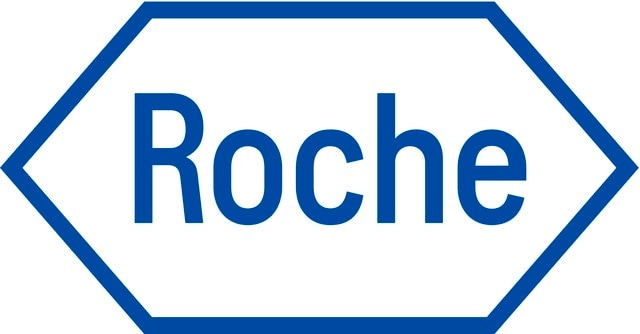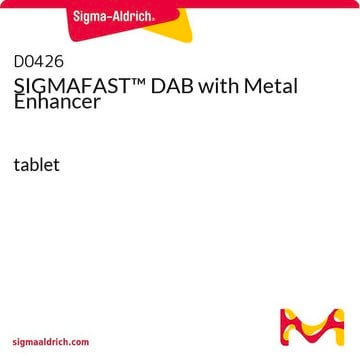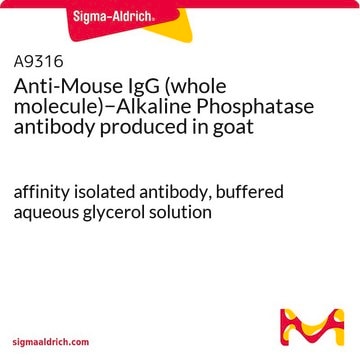D7679
3,3′-Diaminobenzidine (DAB) Liquid Substrate Dropper System
liquid
Se connecterpour consulter vos tarifs contractuels et ceux de votre entreprise/organisme
About This Item
Numéro CAS:
Numéro CE :
Numéro MDL:
Code UNSPSC :
12352204
ID de substance PubChem :
Nomenclature NACRES :
NA.75
Produits recommandés
Forme
liquid
Technique(s)
immunoblotting: suitable
Solubilité
water: soluble
Conditions d'expédition
wet ice
Température de stockage
2-8°C
Chaîne SMILES
Cl.Cl.Cl.Cl.Nc1ccc(cc1N)-c2ccc(N)c(N)c2
InChI
1S/C12H14N4.4ClH/c13-9-3-1-7(5-11(9)15)8-2-4-10(14)12(16)6-8;;;;/h1-6H,13-16H2;4*1H
Clé InChI
KJDSORYAHBAGPP-UHFFFAOYSA-N
Description générale
DAB (3,3′-Diaminobenzidine Tetrahydrochloride) Liquid Substrate Dropper System has been developed for use in immunohistology and immunoblotting procedures as a precipitating substrate for the detection of peroxidase activity. DAB is the immunohistology substrate of choice because it produces an intense brown stain that is easily observed. The end product is resistant to alcohol, therefore, a variety of counterstains and mounting media can be used with the DAB Liquid Substrate Dropper System. DAB Liquid Substrate Dropper System provides all of the chromogen and buffer/peroxide solutions needed to produce a fast and convenient DAB substrate solution.
Application
3,3′-Diaminobenzidine (DAB) Liquid Substrate Dropper System has been used as a developer in immunohistogical examination.
Attention
Stable at least one year at 2-8 °C.
Quantité
Each DAB liquid substrate dropper system will provide ten individual application dropper bottles of 10 mL of a fast and convenient DAB substrate solution.
Composants de kit seuls
Réf. du produit
Description
- 10× DAB Liquid Chromogen 10 mL
- premeasured, ready-to-use buffer/peroxide solution for individual application 10 x 9
Code de la classe de stockage
11 - Combustible Solids
Classe de danger pour l'eau (WGK)
WGK 3
Faites votre choix parmi les versions les plus récentes :
Déjà en possession de ce produit ?
Retrouvez la documentation relative aux produits que vous avez récemment achetés dans la Bibliothèque de documents.
Les clients ont également consulté
N M Chu et al.
The journal of histochemistry and cytochemistry : official journal of the Histochemistry Society, 37(2), 257-263 (1989-02-01)
Immunoblotting techniques are widely used for detection of antigen immobilized on nitrocellulose membranes. There are many immunolabeling methods and staining methods available to disclose the presence of antigen in such techniques. Five common staining methods each for alkaline phosphatase and
CD8+ T cells expressing IL-10 are associated with a favourable prognosis in lung cancer
Miotto D, et al.
Lung Cancer, 69(3), 355-360 (2010)
The duality of beta-catenin function: a requirement in lens morphogenesis and signaling suppression of lens fate in periocular ectoderm
Smith AN, et al.
Developmental Biology, 285(2), 477-489 (2005)
Carola W N Damen et al.
Analytical biochemistry, 393(1), 73-79 (2009-06-16)
For the bioanalysis of therapeutic monoclonal antibodies in biological matrices, immunoassays--especially enzyme-linked immunosorbent assays (ELISAs)--are the most widely used techniques. Although ELISAs are very sensitive, the obtained sensitivity is not always sufficient. In this study, we have investigated the possibilities
S M Hsu et al.
The journal of histochemistry and cytochemistry : official journal of the Histochemistry Society, 30(10), 1079-1082 (1982-10-01)
Three metallic ions, NiCl2, CoCl2, and CuSO4, were found to modify the color of the normally brown diaminobenzidine (DAB) reaction. The colors ranged from purplish blue (NiCl2), dark blue/bluish black (CoCl2), to greyish blue (CuSO4). We have found that the
Notre équipe de scientifiques dispose d'une expérience dans tous les secteurs de la recherche, notamment en sciences de la vie, science des matériaux, synthèse chimique, chromatographie, analyse et dans de nombreux autres domaines..
Contacter notre Service technique









